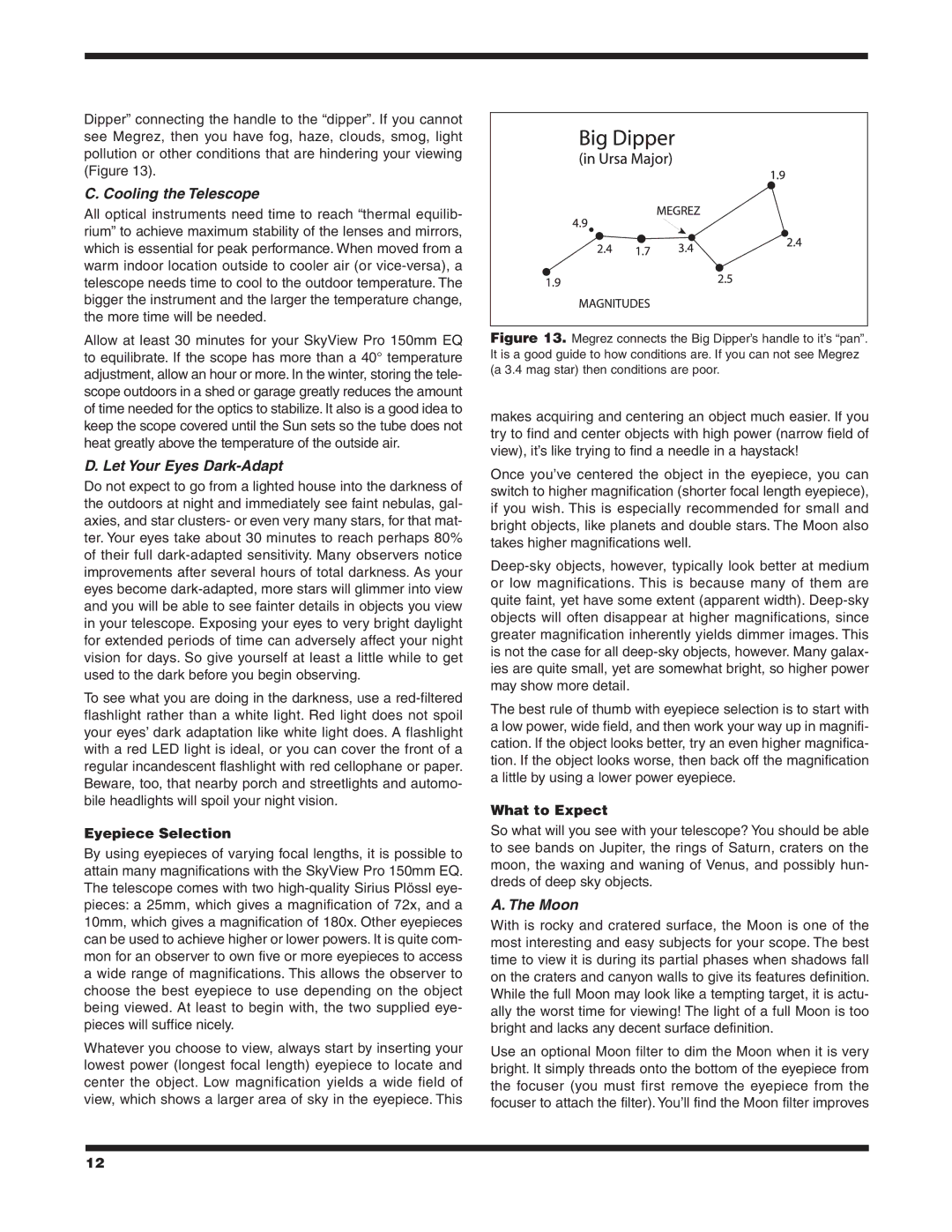Dipper” connecting the handle to the “dipper”. If you cannot see Megrez, then you have fog, haze, clouds, smog, light pollution or other conditions that are hindering your viewing (Figure 13).
C. Cooling the Telescope
All optical instruments need time to reach “thermal equilib‑ rium” to achieve maximum stability of the lenses and mirrors, which is essential for peak performance. When moved from a warm indoor location outside to cooler air (or vice-versa), a telescope needs time to cool to the outdoor temperature. The bigger the instrument and the larger the temperature change, the more time will be needed.
Allow at least 30 minutes for your SkyView Pro 150mm EQ to equilibrate. If the scope has more than a 40° temperature adjustment, allow an hour or more. In the winter, storing the tele‑ scope outdoors in a shed or garage greatly reduces the amount of time needed for the optics to stabilize. It also is a good idea to keep the scope covered until the Sun sets so the tube does not heat greatly above the temperature of the outside air.
D. Let Your Eyes Dark-Adapt
Do not expect to go from a lighted house into the darkness of the outdoors at night and immediately see faint nebulas, gal‑ axies, and star clusters- or even very many stars, for that mat‑ ter. Your eyes take about 30 minutes to reach perhaps 80% of their full dark-adapted sensitivity. Many observers notice improvements after several hours of total darkness. As your eyes become dark-adapted, more stars will glimmer into view and you will be able to see fainter details in objects you view in your telescope. Exposing your eyes to very bright daylight for extended periods of time can adversely affect your night vision for days. So give yourself at least a little while to get used to the dark before you begin observing.
To see what you are doing in the darkness, use a red-filtered flashlight rather than a white light. Red light does not spoil your eyes’ dark adaptation like white light does. A flashlight with a red LED light is ideal, or you can cover the front of a regular incandescent flashlight with red cellophane or paper. Beware, too, that nearby porch and streetlights and automo‑ bile headlights will spoil your night vision.
Eyepiece Selection
By using eyepieces of varying focal lengths, it is possible to attain many magnifications with the SkyView Pro 150mm EQ. The telescope comes with two high-quality Sirius Plössl eye‑ pieces: a 25mm, which gives a magnification of 72x, and a 10mm, which gives a magnification of 180x. Other eyepieces can be used to achieve higher or lower powers. It is quite com‑ mon for an observer to own five or more eyepieces to access a wide range of magnifications. This allows the observer to choose the best eyepiece to use depending on the object being viewed. At least to begin with, the two supplied eye‑ pieces will suffice nicely.
Whatever you choose to view, always start by inserting your lowest power (longest focal length) eyepiece to locate and center the object. Low magnification yields a wide field of view, which shows a larger area of sky in the eyepiece. This
Figure 13. Megrez connects the Big Dipper’s handle to it’s “pan”. It is a good guide to how conditions are. If you can not see Megrez (a 3.4 mag star) then conditions are poor.
makes acquiring and centering an object much easier. If you try to find and center objects with high power (narrow field of view), it’s like trying to find a needle in a haystack!
Once you’ve centered the object in the eyepiece, you can switch to higher magnification (shorter focal length eyepiece), if you wish. This is especially recommended for small and bright objects, like planets and double stars. The Moon also takes higher magnifications well.
Deep-sky objects, however, typically look better at medium or low magnifications. This is because many of them are quite faint, yet have some extent (apparent width). Deep-sky objects will often disappear at higher magnifications, since greater magnification inherently yields dimmer images. This is not the case for all deep-sky objects, however. Many galax‑ ies are quite small, yet are somewhat bright, so higher power may show more detail.
The best rule of thumb with eyepiece selection is to start with a low power, wide field, and then work your way up in magnifi‑ cation. If the object looks better, try an even higher magnifica‑ tion. If the object looks worse, then back off the magnification a little by using a lower power eyepiece.
What to Expect
So what will you see with your telescope? You should be able to see bands on Jupiter, the rings of Saturn, craters on the moon, the waxing and waning of Venus, and possibly hun‑ dreds of deep sky objects.
A. The Moon
With is rocky and cratered surface, the Moon is one of the most interesting and easy subjects for your scope. The best time to view it is during its partial phases when shadows fall on the craters and canyon walls to give its features definition. While the full Moon may look like a tempting target, it is actu‑ ally the worst time for viewing! The light of a full Moon is too bright and lacks any decent surface definition.
Use an optional Moon filter to dim the Moon when it is very bright. It simply threads onto the bottom of the eyepiece from the focuser (you must first remove the eyepiece from the focuser to attach the filter). You’ll find the Moon filter improves

